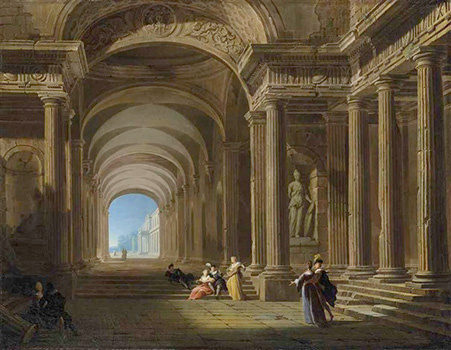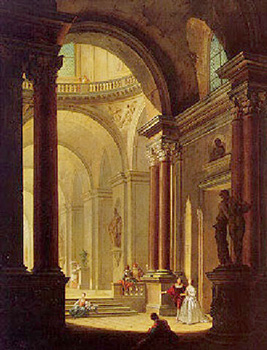
- Home Page
- Accepted
Paintings & Copies - Doubtful
Attributions - Doubtful Textual References
- Alternative
Titles - Collectors &
Museums - Bibliography
- Search Abecedario
- Watteau &
His Circle
L'Intérieur d'une église
Entered March 2024

Destroyed
Oil on canvas
86.4 x 110.5 cm
PROVENANCE
Versailles, collection of Louis XV; by descent to Louis XVI.
Lost at sea, en route to the French Embassy in Constantinople
SELECT BIBLIOGRAPHY
Dezallier d'Argenville, Abrégé (1752), 3: 281.
Engerand, Inventaire des tableaux (1901), 305.
Adhémar, Watteau (1950), cat. 201.Nordenfalk, "L'An 1715" (1987), 31-34.
Michel, Le «Célèbre Watteau» (2008), 143.
Glorieux, Watteau (2011), 242.
Guichané, "Philippe Meusnier" (2018), 20-21.
Guichané, "Watho [sic] pour peindre les figures" (2022), 118.
Eidelberg, "Watteau, A Good but Difficult Friend" (2022), 45.
RELATED DRAWINGS
No drawings have been associated with this painting, neither by Watteau or Meusnier.
REMARKS
Although known only through documentary sources, this large painting—a collaboration between Watteau and Philippe Meusnier (1655-1734)—is one of a few pictures on which Watteau is recorded as having worked with a second artist. His collaborator, Meusnier, was the older of the two, Watteau's senior by twenty-nine years. Although his specialty—architectural perspectives—was a relatively minor genre, Meusnier was the more celebrated of the two when they worked together.
Thanks to the research of Carl Nordenfalk, we know that in 1715 while in Paris, Carl Gustaf Tessin of Sweden visited Meusnier's studio in the Louvre. Tessin reported that the artist claimed that he "employe Watho pour peindre les figures." Confirmation of this is found four years later when the French court commissioned a painting of a church interior, one in which Watteau added the figures. This picture is referred to indirectly by Dezallier d'Argenville, who wrote apropos of Meusnier that "Le Roi possede de ce Peintre, La Représentation d'une Eglise, dont l'ordonnance est des plus belles, et que Watteau eut ordre d'orner de jolies figures." This commission is confirmed in the official royal inventories where this painting is recorded, although under only Meusnier's name. There we learn that the large painting showed "une grande Église avec tous les attributs convenables à une église, comme tribune, etc." For this work, Meusnier was paid 110,00 livres in August 1719. Later in the eighteenth century, after Watteau's fame was established, things reversed; Watteau was named as the primary artist and Meusnier's name was mentioned second, and then not all—a fascinating witness to the fragility of fame.
A plethora of extant paintings by Meusnier allow us ample opportunity to judge his work. In addition to illusionistic murals, there are many easel paintings. These fall into several major thematic groups, especially great palatial halls and spacious salons, often with vistas through arcades. Unlike other contemporary artists who painted architectural perspectives, such as Michel Boyer (1668-1724), who often painted views of the exteriors of palaces, Meusnier specialized almost entirely in interiors. Curiously, though, none of these pictures depict church interiors except for the one he executed with Watteau. On the other hand, Meusnier's lost composition can easily be imagined—with steeply receding diagonal walls, a vaulted ceiling, and contrasting pockets of light and dark. So too, judging by the staffage in Meusnier's extant paintings, it is easy to imagine how Watteau could have arranged his figures within the space allotted to him. In fact, in the broadest sense, Meusnier's own handling of courtly figures is close to Watteau's, making their work visually compatible.
Other paintings by Meusnier have figures executed by a second hand. Most notable are the two pictures in the Musée des beaux-arts in Nancy with staffage by Jean-Baptiste Pater, works commissioned by Louis XV. Also, there is a Meusnier picture with figures by Nicolas Lancret. Yet there are no additional examples where Meusnier collaborated with Watteau. As modern scholarship is now revealing, from time-to-time Watteau collaborated with other artists such as Antoine Dieu and Francisque Millet. Yet there is little evidence of Watteau being closely allied with Meusnier. Their association was already in place by 1715 and their collaboration in 1719 shows that it continued, but perhaps only sporadically. For the present, there is no evidence of a close, sustained working relationship between the two men.

